
Today we are going to talk about Belgian Malinois colors. Intelligent, athletic, and workaholic, the Belgian Malinois is one of the most popular breeds of working dogs, frequently in service with law enforcement and the military.
Have you ever wondered why they look so different from each other even though they are purebred? The Belgian Malinois breed has 12 different coat colors, which they can inherit from their parents!
In this article, you’ll learn everything about the different Belgian Malinois colors from a brief history of the dog, why they have many colors, what are these colors, and frequently asked questions about the colors relating to their health, age, and temperament.
Other articles you would like: Meet The Belusky and Is A Malinois German Shepherd Mix Right For You?
Table of Contents
What Are The Different Belgian Malinois Colors?
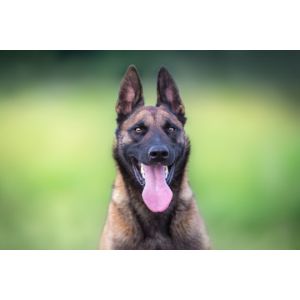
According to the American Kennel Club (AKC), Belgian Malinois has five main colors that range from mahogany to fawn.
Note that all the below-mentioned colors will not cover the whole body. The standard of black covering the eye rims, ears, and muzzle will stay the same for all dogs despite their color.
Mahogany

The brown, deep color of wood, the color is named after mahogany wood. A brownish Mahogany color covers the complete body except for the black muzzle, eye rim, and ears.
Red
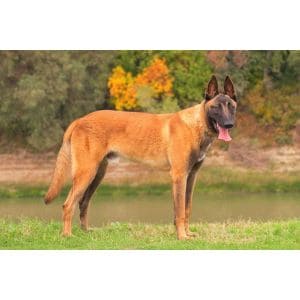
This means that the coat takes a reddish hue completely except for the black muzzle, eye rim, and ears.
Red Sable
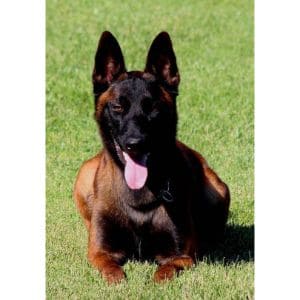
This is not one of the Belgian Malinois colors but rather, a black pattern which means that the red color doesn’t completely cover the coat but rather has black mixed with red. These black patches in varying sizes can be on their stomach area or around the coat nearer to the limbs.
The intensity of the pattern changes from one dog to another.
Fawn
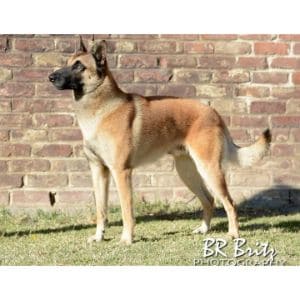
Fawn is close to the beige palette or a milk coffee-like mix. Fawn covers the coat completely except for the black muzzle, eye rim, and ears.
Fawn Sable

Like the red sable, the fawn sable is mainly fawn but has black patches around the stomach and limbs.
While these are the five main colors approved by the AKC, there are seven more color variations that are accepted by other organizations such as the Canadian Kennel Club, United Kennel Club, and Federation Cynologique Internationale (FCI).
However, if you are looking to show your dog in conformation, you might be better off sticking to the more accepted colors listed above.
Black
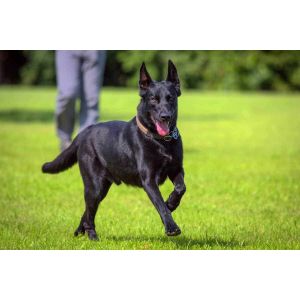
Black is one of the rarest of the Blegian Malinois colors. It is quite rare to find a black Belgian Malinois, and it is not considered standard. But they do exist and have a beautiful, intimidating aura around them.
Brindle

Brindle is also a pattern; it indicates a mixed palette of brownish hues and it looks like a stripey pattern similar to horse skins. Typical brindle Belgian Malinois colors will have black skin with brownish-orange stripes. You might have seen cats with this same pattern too.
Cream

Cream is the yellowish version of real cream, and it is close to the fawn but the fawn is darker. Cream covers the body completely with the exception of the black muzzle, eye rim, and ears.
Cream Sable

One of the most striking of the Belgian Malinois colors, cream doesn’t cover the coat completely. The coat generally has a cream coat with patches of black.
Gray

Gray can also be called blue, it’s a variation of the black color but this color is quite rare. Gray covers the body completely except for the muzzle, eye rim, and ears.
Gray Sable
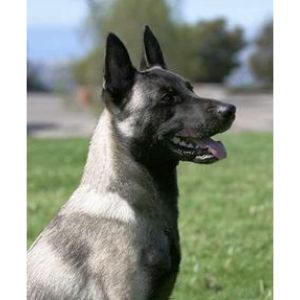
Gray doesn’t cover the coat completely but rather has black patches on it.
Liver

Liver is a hue between red and mahogany. Liver color covers the body completely except for the black muzzle, eye rim, and ears.
These are the known Belgian Malinois colors from across the world, but there’s another color that is approved only by the Canadian Kennel Club: white. This might seem weird but white Belgian Malinois do exist.
Differences Between A German Shepherd And A Belgian Malinois

Both German Shepherds and Belgian Malinois are popular breeds of dogs, known for their intelligence, loyalty, and athleticism. However, there are some key differences between these two breeds that potential owners should be aware of.
German Shepherds are typically larger than Belgian Malinois, with males averaging around 26 inches in height and females around 24 inches, and weighing in at about 85-100 pounds.
Belgian Malinois are just as tall but weigh only 40 to 60 lbs for females and 55 to 75 lbs for males.
German Shepherds also tend to be slightly calmer than the Belgian Malinois, making them better suited for families with young children.
Belgian Malinois, on the other hand, are considered to be one of the most energetic dog breeds. They require a great deal of exercise and can become easily bored if left alone for too long.
They are also known for being very protective of their families, which can make them aggressive towards strangers.
What Is The Rarest Of The Belgian Malinois Colors?
The rarest color of these is the brindle color or pattern, which is black with stripes of brown or orange. What makes it the rarest is that it is said that Belgian Malinois got this color from an early ancestor during its herding days.
The gene lay dormant and is carried by several generations before surfacing again years after.
What Are The Common Colors Of The Belgian Malinois?

The most common colors are the five standard Belgian Malinois colors which are mahogany, red, red sable, fawn, and fawn sable. Pure black is also relatively common. All these colors are approved Malinois colors.
Does The Color Change As A Belgian Malinois Matures?
Unlike some other dog breeds, Belgian Malinois don’t change colors as they grow.
Some dogs can shed their puppy coats and grow another coat for adulthood which can be a different color or even a different pattern than the one they had as puppies.
This, however, doesn’t apply to the Belgian Malinois, because the color is determined by the genes and will stay the same as the puppy grows.
Although the Belgian Malinois shed a lot of hair during spring it won’t change color. The only thing that might change in the coat color is that it might get lighter, but it will never change from red to say, white, or mahogany to cream.
Does The Color Matter To A Belgian Malinois Temperament?
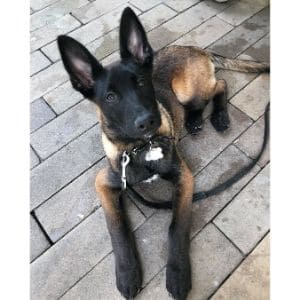
Belgian Malinois colors don’t determine anything about the dog’s temperament or behavior. It will only affect the way people and other dogs perceive them.
For example, black Belgian Malinois will look more dangerous than cream or fawn, while mahogany or red will look funnier and less intimidating.
The same concepts for humans with different hair colors and cuts, affect how people judge them but they are not an indication of their character.
Does The Color Matter To A Belgian Malinois Health?

In terms of overall health, no. Their overall body and organ health are not affected by the game. The only thing affected by the genetic game will be the coat.
This means that they can develop diseases related to the genes called such as Color Dilution Alopecia (CDA)
CDA is a coat disease that causes the patches of hair to fall which leaves the skin itchy and flaky underneath, and the hair doesn’t grow back.
This disease is not curable but it is quite manageable, using ointments can help solve the issue for the doggy and they will still be cute in your eyes.
It is mostly more common in Mals that have a lighter coat shade or a diluted color like fawn or grey coats.
Should You Pick A Belgian Malinois Based On Color?
If you’re thinking about colors before buying or adopting a Malinois, you should think about a few things.
Are you going to enter your doggo in conformation shows? If so, you might want to make sure the Belgian Malinois colors fit the breed standard approved by your governing organization.
Another factor is cost. Malinois with rarer colors will cost more, while common colors tend to cost less.
The third thing you should consider is CDA disease. If you will have a problem when your dog loses hair then you might want to keep away from the diluted color coats. However, it is one of the many diseases that can get any dog.
Instead of picking a dog based on aesthetics, it would be better to look at genetics and lineage instead to avoid getting a dog that can get a genetic condition passed down from poor and irresponsible breeding.
Like any dog, the Belgian Malinois are predisposed to certain conditions. Some of the most common health problems that Belgian Malinois suffer from include hip dysplasia, elbow dysplasia, and epilepsy.
Who Is The Belgian Malinois?
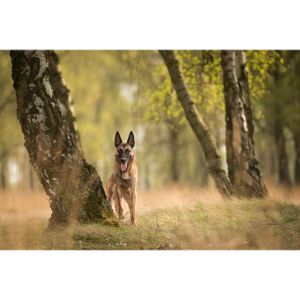
Belgian Malinois is an authentic noble dog that has a long history of guarding. It was first bred in Belgium for the purpose of herding and taking care of sheep.
They are part of four breeds that were bred in Belgium for the same purpose, and all four breeds fall under the Herding Group.
They even got their name Mlalinois from the Belgian City of Malines. From Belgium, they moved to the US to be mostly police and military dogs. They were infamous for their role during World War I.
These days, they are famous Navy SEALs, military dogs, and police dogs who have many heroic stories in the field.
How Does A Belgian Malinois look?
Belgian Malinois looks a little like the German Sheperd, but they are thinner and taller and have longer legs. They also differ in their coat color and they have thinner and shorter coats.
They have two coats; a soft, downy undercoat to insulate them and protect them from the cold, and a tough, wiry overcoat that repels water, dirt, and grime.
All Belgian Malinois are characterized by a black pointy muzzle, blackness around the eye rim, and blackness on their pointy ears. These are standard for all Belgian Malinois, while the rest of the coat can differ.
Belgian Malinois have a short, dense coat that is black with brown or red markings. They are a medium-sized breed, typically weighing between 40 and 80 pounds.
While they may not be the best choice for first-time dog owners, Belgian Malinois make wonderful pets for those who are willing to put in the time and effort to train them properly.
Why Do They Have Different Colors?

All dogs can inherit two pigment genes from their parents, the one responsible for the dark colors like black and brown, and the one responsible for the red and yellow hues.
Genes in Belgian Malinois can work to dilute the color, which means that a dog can have the red pigment gene, but it gets a shade lighter turning to yellow.
It’s just a gene can surface differently from one generation to the next. Some dogs can carry a gene from one generation to the next but the gene only gets activated in their pups.
How Can You Tell If A Belgian Malinois Is Purebred
Because of the different colors, it is often hard to identify a purebred Belgian Malinois yet it is always helpful to know the standard of colors which are approved by international organizations.
However, there are two ways, besides the color, that you can determine if the dog is purebred.
if the dog has a breeding certificate, you can rest easy on its lineage. Breeding certificates are always found with professional breeders.
Another way you could make sure is by making a DNA test. DNA tests for dogs have become increasingly popular in recent years as pet owners strive to learn more about their furry companions.
While the information contained in a dog’s DNA can be fascinating, it can also be very useful in terms of health and well-being.
For example, DNA tests can help to identify genetic diseases that a dog may be predisposed to, allowing owners to take steps to prevent or manage these conditions.
DNA tests can also be used to determine a dog’s ancestry, which will help determine whether the Belgian Malinois is a purebred one.
In the past, DNA tests for dogs were often inaccurate, providing results that didn’t quite match up with the physical appearance of the dog.
However, newer tests are much more reliable. The most accurate DNA tests on the market today can provide results that are up to 99% accurate.
Conclusion For “Belgian Malinois Colors Explained”
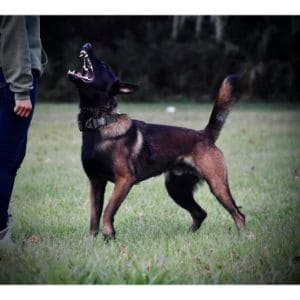
The Belgian Malinois is an intelligent, energetic breed of dog that requires a great deal of exercise and attention. While they make excellent companion animals for active people, they are not the right breed for everyone.
400;”>Belgian Malinois are working dogs, and as such, they require a great deal of stimulation and activity in order to stay happy and healthy. If left alone for too long, they can become destructive or even aggressive.
They also need a great deal of early socialization in order to prevent them from becoming overly suspicious of strangers.
As a result, Belgian Malinois are not the best choice for people who work long hours or who live in apartments or other small spaces.
However, for people who are able to provide them with the exercise and attention they need, Belgian Malinois can make wonderful, loyal companions.
All of these colors are beautiful, but each one has a unique personality. No matter what color your Belgian Malinois is, they will be the best friend you’ve ever had!
You will also like:
- Do Belgian Malinois’ Ears Stand Up?
- Why Do Police Use Belgian Malinois?
- Proper Exercise For A Belgian Malinois
For more information about Belgian Malinois Colors, check out the video below:




